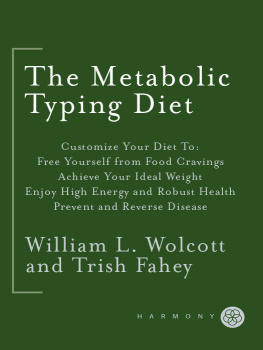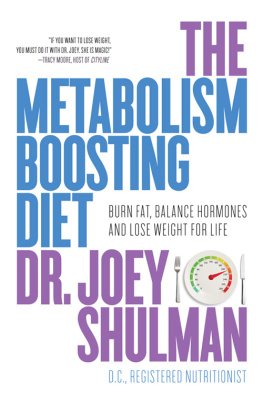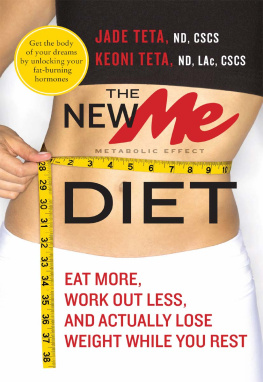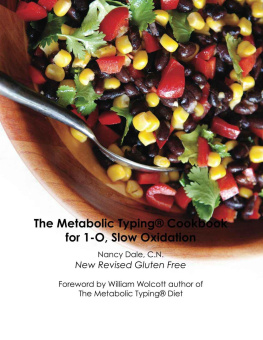Copyright 2000 by William L. Wolcott and Trish Fahey
All rights reserved.
Published in the United States by Harmony Books, an imprint of the Crown Publishing Group, a division of Random House LLC, a Penguin Random House Company, New York, www.crownpublishing.com
Harmony Books is a registered trademark, and the Circle colophon is a trademark of Random House LLC.
Originally published in hardcover by Doubleday, a division of Random House LLC, New York, in 2000. It is here reprinted by arrangement with Doubleday. Subsequently published in paperback by Three Rivers Press, an imprint of the Crown Publishing Group, a division of Random House LLC, New York, in 2002.
Wolcott, William L. (William Linz)
The metabolic typing diet : customize your diet for permanent weight loss, optimum health, preventing and reversing disease, staying young at any age / William L. Wolcott and Trish Fahey.
p. cm.
Originally published: New York : Doubleday, 2000 (without a subtitle).
Includes bibliographical references.
1. Reducing diets. 2. Metabolism. I. Fahey, Trish. II. Title.
This book is not intended as a substitute for the medical recommendations of physicians or other health-care providers. Rather, it is intended to offer information to help the reader cooperate with physicians and health professionals in a joint quest for optimum health. Unless otherwise noted, the identities of people described in the case histories have been changed to protect their confidentiality. Neither the publisher nor the author is responsible for any goods and/or services referred to in this book, and both expressly disclaim all liability in connection with the fulfillment of orders for any such goods and/or services for any damages, loss, or expense to person or property arising out of or relating to them.
Its impossible to adequately acknowledge and thank the scores of people who contributed to the development of this book.
Like many people involved in nutritional research, Im very grateful for the scientific legacy of great innovators such as Weston Price, D.D.S.; Francis Pottenger, M.D.; Royal Lee, D.D.S.; Roger Williams, Ph.D.; George Watson, Ph.D.; Henry Harrower, M.D.; Henry Bieler, M.D.; Melvin Page, D.D.S.; Elliott Abravanel, M.D.; James DAdamo, N.D.; Peter DAdamo, N.D.; Dietrich Klinghardt, M.D.; and the remarkable Emanuel Revici, M.D.
Im especially indebted to William Donald Kelley, D.D.S., for his brilliant contributions in the field of clinical nutrition and for his central role in launching the exciting and evolving field of metabolic typing. We are also very grateful to Guy Schenker, D.C., whose pioneering work in metabolic individuality is an ongoing inspiration.
Very special thanks go to Ron Hoffman, M.D.; Don Davis, Ph.D.; Leo Roy, M.D.; Ron Hunninghake, M.D.; Sherry Rogers, M.D.; Daniel Fahey, M.D.; Anne Louise Gittleman, M.S.; Milo Siewert, M.D.; Gabriel Cousens, M.D.; Harold Grams, D.C.; Doris Rapp, M.D.; Peter Konigs, N.D.; Etienne Callebout, M.D.; David Vaughan, N.C.; Andreanna Vaughan, R.N.; Karen Gorney, R.N.; and the extraordinary Paul Chek.
My heartfelt appreciation goes to Harold and Adele Smith and to Scott Baker for their many years of exceptional work and collaboration. Im also deeply indebted to June Hutchins, Leni Felton, Sam Biser, William Fioretti, and Sam Caster.
A very special thank you goes to Judy Kern and Michael Palgon at Random House, and to the fine editorial team at Broadway Books, including Ann Campbell and Amanda Gross. Thanks also to our agent, Katherine Cowles; to our talented illustrators, Einat Peled and Yina Zhang; and to Tina Thompson and Chris Fortunato, who did such an excellent job designing and producing the book.
Were very grateful for the support and keen insights of Anita Shapiro, Dennis Gronek, Michael Calvey, Jodie Garay, Laura Hinthorn, Mark Worthington, Joan Fahey, Henry Lin, Lery Lin, Elaine Schweitzer, Jo Schweitzer, Ruth Moss, Diana De Lucia, Adrian Van Caneghem, Debra Lesser, Michaelyn Harris, Penny Lucas, Steve Pollack, and Laurie Cowan.
Pat Connolly and the entire team at the Price-Pottenger Nutrition Foundation are treasures, and were all deeply indebted to them for their many years of invaluable work. Were also very grateful to the brilliant Audrey Kramer, whose efforts dating back many years were so instrumental in putting this process in motion. Thanks also to Kenny Kramer, Allyson Kramer, and Kathleen McCann.
A special acknowledgment goes to Sherri Maver and to the late Robert W. Maver, F.S.A., whose life and legacy as a pioneer in alternative medicine continue to inspire us all. In addition, this project would not have been possible without the talent, support, and generosity of Mary Jo Fahey, Bruce Anderson, Peter King, Barbara Tanis, David Schmuller, Penny Lucas, and Kathleen Mulcahy.
Dodie Hayes Anderson deserves very special thanks for vital contributions to the practical portions of the text, and for extraordinary leadership, insights, and expertise as a health educator.
Above all, Id like to thank my family, especially my wife, Suzi, whose remarkable talents, wisdom, and dedication have made so much possible for so many.
Finally, I dont know how to begin to thank Trish Fahey, whom I am so fortunate to have as my coauthor. The book could not have been written without her unique talents, vision, and depth of knowledge. I owe her a debt of gratitude Ill never find words to express.
William L. Wolcott
I first began to investigate metabolic typing almost fifteen years ago, after hearing reports of the exceptional clinical results that people were achieving with it. I was intrigued when I learned of this novel nutritional technology, one that somehow enabled clinicians to identify the highly specific dietary needs of individuals. At the same time, I was skeptical. It sounded a little too good to be true and was based on concepts that seemed highly unconventional, even within the context of alternative medicine. Nonetheless, I decided to follow up on the subject, in case there was something of value I might discover.
Back in the 1980s I was, like many other clinicians, a true believer in the value of diet and nutrition. But like everyone else, I was continually frustrated by the contradictions and complexity inherent in nutritional science. Nutritional therapy clearly held a great deal of potential as a primary therapeutic approach, yet there were many practical challenges involved in applying it in clinical settings. Health professionals simply had no reliable means of evaluating peoples dietary deficiencies and recommending predictably effective nutritional protocols. Time and again I had encountered the same frustrating dilemma: A dietary program that worked very well for one person would produce little or no beneficial results for someone else. There seemed to be no readily available solutions on the horizon.















